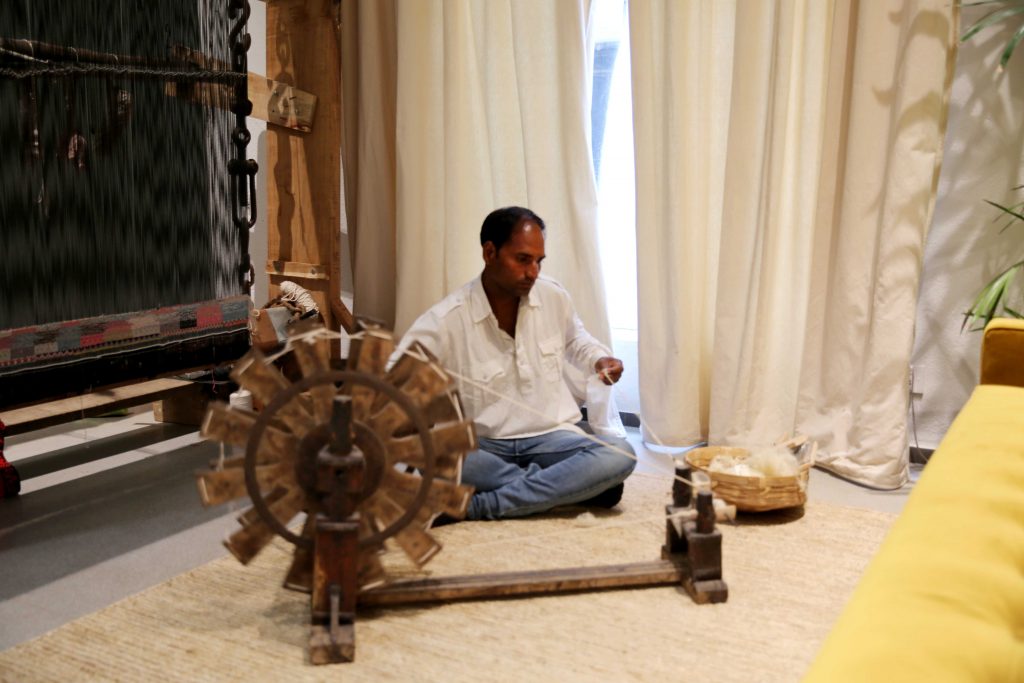Jaipur Rugs brings luxury leaders together for a panel discussion on conscious luxury
Husein Haveliwala
As soon as you enter Jaipur Rugs’ 4,000 sq. ft. retail space, an Ambassador automobile clad in carpets welcomes you; an installation in collaboration with designer Shantanu Garg. As you move into the next space, weaver couple Sonia Devi and Madanlal from Aaspura, Rajasthan, greet you with a spinning wheel and loom. And then opens up the sprawling main hall of the showroom, with rugs hanging on the walls from floor to ceiling.

But the main event that day was taking place above it all; literally. In a naturally lit loft, a group of four highly experienced individuals discussed an issue that needed a voice and a name. The name is ‘conscious luxury’, and the individuals are Yogesh Chaudhary, the Director of Jaipur Rugs (who moderated the panel), Srila Chatterjee, an interior stylist and the founder of furniture and décor store Baro (a minute’s walk down the lane from Jaipur Rugs), Nirav Shah, founder of bespoke design firm Advanced Concepts & Design Studio (ACDS), and Vikas Purohit, the CEO of Tata CLiQ.

Chaudhary kicked off the talk by asking the panellists to elucidate what the phrase ‘conscious luxury’ meant to them. Chatterjee linked the often incorrectly interchanged words ‘conscious’ and ‘conscience’ here, implying that one must have a conscience to be able to practice luxury consciously and that it must stem from everyday activities. Shah, from an architect’s viewpoint, believes that conscious luxury involves translating efficient ideas to designs and then executing them on-ground. Designing and constructing luxurious homes, Shah takes the first step by proposing, to his clients, ideas such as using locally sourced material palettes.
The primary stakeholders in the entire exercise, according to Chaudhary, are; the brands who are selling, the governments who are influencing/regulating, and the customers who are consuming.
“Stories are paramount for brands. Complete, honest stories.”
Srila Chatterjee, founder, Baro
Brands must communicate to consumers why they’re doing what they are, and not waiver from their story. Greed must be stemmed somewhere, and while this may cause a loss in short term revenue, brands gain a lot more in the grander scheme of things. Purohit cites the example of brands like Body Shop, that are very open about their ‘no animal testing’ policy, without compromising on the quality and price. “You can’t sell the concept of consciousness and sustainability at ten times the price. That won’t work either.”

When it comes to the government’s involvement in the process, the importance of regulation was agreed upon across the board. According to Chatterjee, people need to be forced first, and they eventually understand the importance of issues. And, the government plays a big role in this process. Purohit believes it’s about public knowledge. “The day the US government started displaying calories on packaged food items was the day Americans got health conscious,” he says. For him, letting consumers know that a certain pair of jeans used ten litres of water to manufacture, over another pair of jeans that used five; is a more effective method for people to act accordingly. And for companies, tax slabs should be in proportion to the amount of electricity and water used in the manufacturing process.
Contradicting Purohit’s earlier sentiment, Chatterjee accepts the need for giving such products snob value to boost demand, and to make consumers believe what they’re paying for is worth it. “You have to make these products aspirational. People shouldn’t be purchasing them reluctantly, neither should they be shoved down their throats,” she says. Shah is confident that conscious luxury products work well with millennials as they are more willing to adapt. However, he adds, when choosing to support such initiatives, they expect a visible impact. Shah also finds urban luxury consumers more likely to go for sustainable alternatives, as compared to their semi-urban counterparts; as the latter first want to own and experience things the former already has.

The discussion concluded with panellists listing some brands that efficiently follow the conscious luxury movement. International labels such as Stella McCartney and her collaboration with Adidas were mentioned. On shores closer to home, Puducherry-based leather goods manufacturer Hidesign has made the decision to use vegetable dyes instead of chemical catalysts, even though the former takes 28 days as compared to five with the latter. Oorja, with its roots in Bengaluru, creates lighting and home décor solutions from sustainable materials such as banana fibre. In the fashion segment, brands like the Mumbai-based I Was A Sari creates clothing pieces, shoes, bags, jewellery, scarves, and other accessories from old saris. Maya Bazaar employs migrant labourers in Mumbai that had to give up artisanry due to the economic crunch, to make intricate jewellery.
View this post on Instagram



